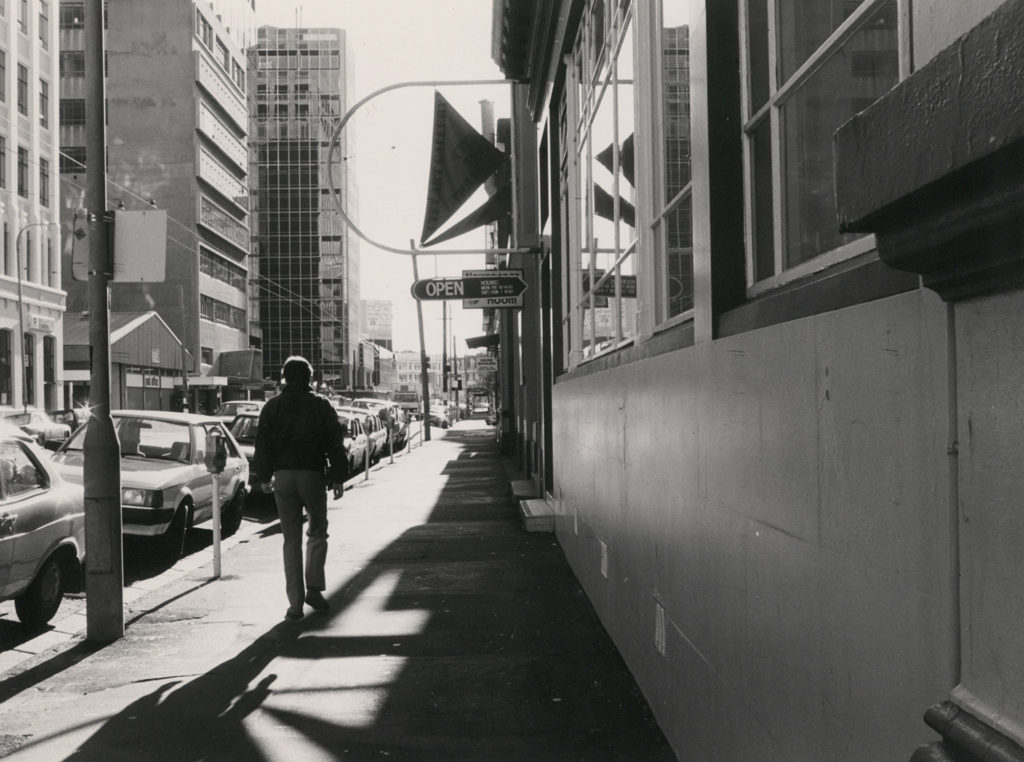CURATORS Greg Burke, Matthew Goldie
Flashback and Shifting Ground are the last shows at 65 Victoria Street, as the Gallery shifts to its temporary location in Chews Lane. The Victoria Street building is being demolished to make way for the new Wellington Public Library building. The Gallery plans to move permanently into the old Library building in Civic Square, after a major refurbishment. Flashback documents the Gallery's short history, since opening in 1980. It features memorabilia from each year of the programme: posters, flyers, photos, and catalogues (displayed on sloped tables). There's also video documentation (including Kaleidoscope footage from 1983 of Director Ann Philbin). Text panels offer insights into the Gallery's community origins and chart its growing pains. The ongoing struggle to find a permanent home is a recurring theme. Several artworks are shown, including a Greer Twiss sculpture (from his 1981 survey), Robyn Kahukiwa's Hinematioro (from her 1988 residency and culminating show Whakamaemae, with artist Shona Rapira Davies), and Vivian Lynn's Book of Forty Images. Flashback also traces the Gallery's interconnections with the Library. The Library opened in 1940 and held small art displays until 1947, then larger exhibitions of artists including Colin McCahon, Gordon Walters, and Toss Woollaston, until 1949.
•
1980
Inaugural director, Seddon Bennington, starts on April Fools Day. The annual budget is $40,000 from the Wellington City Council. Further funds from the Art Galleries and Museum Scheme (Internal Affairs) are allocated to refurbish the Victoria Street site. The exhibition space is 265 square metres, there are three full-time staff, and shows run every 4–6 weeks.
1981
Greer Twiss's A Survey is the first major touring show and retrospective of an artist organised by the new Gallery. The first catalogue is published to accompany the survey.
1982
In May, Bennington resigns telling the Evening Post, that despite support for the gallery it is, 'Falling short of its responsibilities, staff were frustrated, work was not given the attention demanded and the gallery's frontage was unsatisfactory.' A Friends of the Gallery group is established to offer support and guidance. In Anne Philbin is appointed Director, along with two permanent staff, an Exhibition Designer and a Gallery Technician.
1983
The staff are joined by the first Educator Officer, who is able to implement school holiday programmes for families and children that complement the main exhibition programme. The Stuffed Stuff Show, a touring exhibition of fabric sculptures, is a crowd pleaser bringing in the largest audiences to date.
1984
Welcomes the first major regional survey of Wellington art and also the first external curator, Vivian Manthel, who is hired to organise the Water/Clay exhibition, pairing local watercolour painters and ceramicists to create joint projects.
1985
Ann Philbin is the second Director to resign after a short tenure, she leaves for Mana College as head of the art department, citing better pay as her reason. 'My job requires an enormous amount of expertise. When you work from a gallery that is not beautiful or grand—that does not even have a fridge or public toilets for functions—you have to sell your ideas,' she tells the Dominion.
Two months later, John Leuthart takes up the Director position, arriving from a role as Education Officer at the Dowse Art Museum. Long-term plans to rehouse the gallery in the old BNZ building are replaced by a new, more affordable, short-term possibility—a move to the old post office site on Chews Lane.
1986
Robert Shay is the first international artist-in-residence at the gallery. He works out of Eastbourne as the gallery itself is not equipped to provide a studio space.
1987
The Print Series is organised by Education officer and printmaker Jill McIntosh, a compilation of eighteen exhibitions of printmakers running throughout the year. Greg Burke is hired as the first curator, changing the exhibition run period from four-to-six weeks, to eight-to-ten weeks, in order to improve the quality of exhibitions. In September, the gallery's long-term administrative links with the library end, and a separate advisory board is established.
1988
The hours are extended and a late-night programme of live acts, bands, lectures and seminars launched every Wednesday. A new policy is devised with the objectives, 'To provide a people orientated, professional facility, which presents a programme of art, cultural issue and event in the centre city.' By the end of the year, there are nine full-time staff including a new Exhibitions Manager. The hard work pays off and the year sees the highest attendance records to date.
The gallery is ready for its next step—an interim move to Chews Lane, preceding its relocation to the Library Building in association with the Civic Square development in 1992.





































































